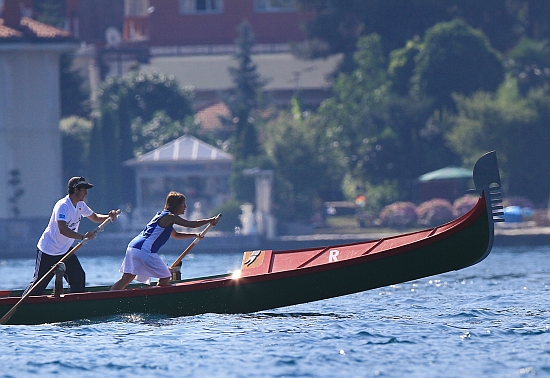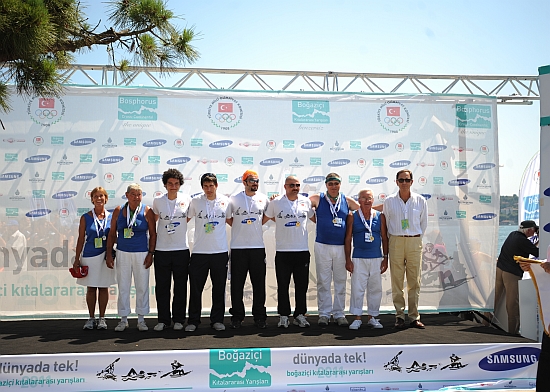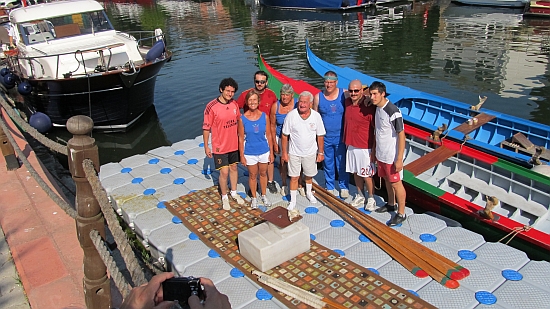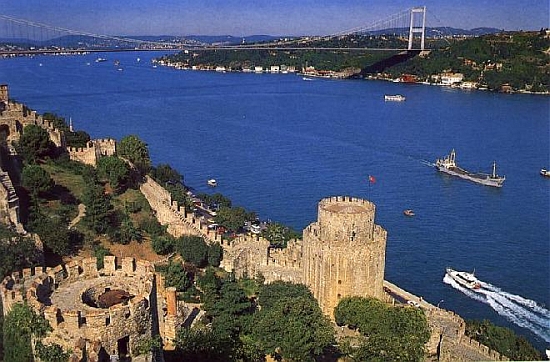Would you like to know how to say “So big your mind vaporizes in front of it” in Turkish?
Answer: “Bogazici.”
In English it’s “Bosphorus,” which is actually Greek, but whatever you want to call it, you’ll say it standing at attention.
And we were out there on July 17, four of us from Venice and four Turkish men, in two gondolas, rowing across it.
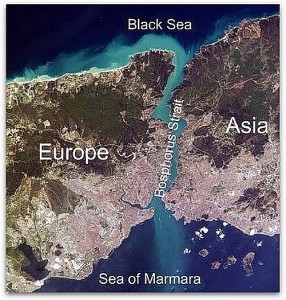
So what’s so big about it? In normal human terms, the world’s narrowest strait used for international navigation isn’t all that big. It’s about 31 km/17 nautical miles long and its maximum width is 3,329 meters/1.7 nautical miles and its minimum width is a mere 704 meters/.38 nautical miles. But unless you need to pilot a tanker of liquefied natural gas or something, these numbers don’t tell you its true dimensions.
When you row out onto it in a four-oar gondola, the whole concept of size suddenly multiplies in every direction. I knew there were currents and vortexes and so on, though Lino in the stern knew how to deal with them so I, rowing in the bow, didn’t pay much attention. But I didn’t know then that the Black Sea to the north and the Sea of Marmara to the south flow toward each other with differing densities, which forms an underwater river in the Bosphorus which, if it were on the surface, would be the sixth largest river (in volume, I presume) on earth.
It’s probably better I didn’t know that.
-
The Rumelihisari fortress was built by Sultan Mehmet II in 1451-52. The Fatih Sultan Mehmet Bridge is also named for him ("Fatih" means "Conqueror"). We were out there, smaller than any boat shown here, rowing back and forth in front of it, focusing on not being conquered by the waves. Photo: Sagredo
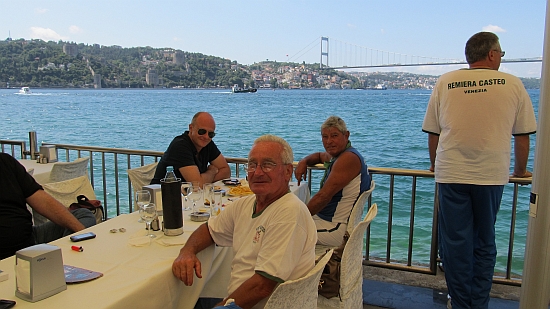
What I did feel was not only the mass of water under us, I felt the mass of history bearing down on this strip of sea which by now is so heavy there ought to be a black hole there instead of mere water. It’s not every day I get to row around in front of a Turkish fortress built in 1451 to enable the Ottoman assault which conquered Constantinople in 1453.
And just for the record, Lino told me later than when we rowed out there, he had a lump in his throat, for the very same reasons I was listening to my brain spinning its wheels saying “I cannot believe I’m out here doing this.” The fact that he could get emotional is a great thing — and that he could be dealing with the throat-lump while also keeping track of the vortexes is even better.
Gondolas on the Bosphorus — how weird is that? Despite the fact that, somewhere back in history, there were plenty of boats our size being rowed all around here, we were thrillingly tiny. Under the soaring Fatih Sultan Mehmet suspension bridge the passing ocean-going tugboat and the double-decker tourist boats and the random tanker, all of which seemed to have three-million-horsepower motors and created waves the size of Quonset huts, made rowing a fairly unusual thing to be doing out here. Possibly the people aboard the aforementioned craft thought so too, though I’m not sure we even showed up on their radar. Certainly the tourists were excited to see us, waving and snapping pictures, though only God knows what they were thinking as we passed. They certainly weren’t thinking about the massive wake they were leaving behind them.
- This is the Bosphorus at its peerless best. We are toiling toward the Bosphorus Bridge, the second of only two across the strait. The finish line was almost in sight (imagine applauding hordes to the right of the frame). Courtesy Olympic Committee of Turkey
So we were there just to be weird? Mais non, mon capitaine. Thanks to the collaboration of His Excellency Gianpaolo Scarante, the Italian Ambassador to Turkey, we were invited to be the opening number in the spectacle of the Bosphorus Cross Continental, an annual event organized by the Turkish Olympic Committee, the only swimming event in the world which involves two continents.
Some 1,200 swimmers plunge into the water like penguins off an ice floe from a dock on the Asian shore of Istanbul and swim to the European side, a distance of some 6 km/3.8 miles, with the bonus of having to turn around and do the last stretch against the current.
But Venetian boats in Istanbul? Of course there were plenty here when it was Byzantium, and plenty even after it became Constantinople. But given much of the history between Venice and Turkey, it was a very cool thing to be there all together — two Venetians and two Turks per boat — with absolutely no ulterior motive, like buying, selling, or slaying.

Traffic is blocked for four hours to smooth the stage for the mob of Australian-crawlers (and the small pod of dolphins we saw arcing around the finish line). If delivery of your new plasma TV is held up, maybe you could blame it on this. In any case, we also benefited handsomely from this blockade, benefited, that is, until about ten minutes from the finish line, when two double-decker tourist boats carrying the swimmers upstream passed by. The swimmers waved at our brilliant strangeness and beauty but didn’t notice the wake. Our gondola stolidly took the three or four walls of water head-on — womp, womp, womp — but it isn’t good for the boat and it really slowed us down. When you’re panting to reach the finish line, hot and sweaty, being slowed down is intensely annoying. Still, compared to the gymkhana of yesterday, with waves from everywhere, it wasn’t so bad.
Lino’s and I, with Ata and Samet on the red-and-green gondola, finished second. I don’t say we lost, nor do I say the blue gondola won, because the boats were totally mismatched in several technical but telling details. Also, it wasn’t supposed to be a genuine race; Ata and Samet, and Burak and Mehmet, had only tried Venetian rowing twice in their lives, on Friday afternoon and Saturday morning. It’s just that the desire to see no one in front of them overcame the sporting good sense of our adversaries. I didn’t care if they came in first. I did care that they did it by five or six boat-lengths.
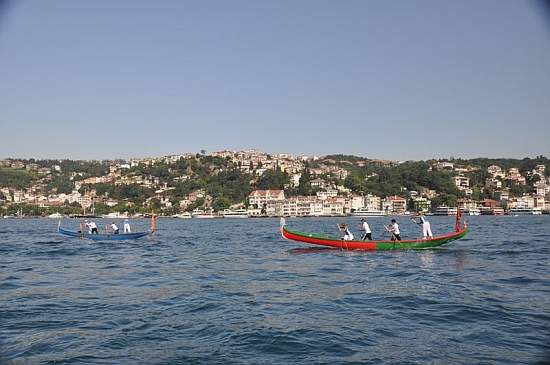
So what could be next? I’d be perfectly happy if we were to be able to do this again next year. Otherwise, unless we find a way to tackle the Bering Strait, or maybe the Strait of Malacca, I’m going to leave this experience in lonely splendor at the top of a list of one, labeled “If this doesn’t astound you, you must be completely missing your astound-o-meter.”
